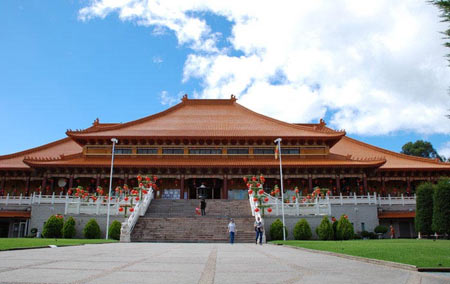The origin of buddhism in Australia would be traced back to 1848 when the first group of chinese miners arrived in the continent in south, bringing the ideologie of Confucius and Buddha.
In the 19 centry, not long after the establishment of the state, buddhism is introduced to Australia by the merchantmen and immigrators from Sri Lanka, within a very limited population as there are not many Sri Lankans. It is not until the 20th centry that the buddhism arouses the interest of the europeans and reseachers from western countries began to propagate the religion in the society of Australia as soon as they sattled there. In 1910, the English origined buddhist master U Sasana Dhaja came to Australia and became the first propagandist of Buddhism on this continent. Sister Dhammadinna, born in the United States, arrived in Australia at age of 70 in 1951 and is also one of the initiators of buddhism in the country.These western missionaries were in fact considered as the initiators of buddhism in Australia, as they are good enough in English to express the esstiential idea clearly to the majority of Australian society.
There are various buddhism schools in Australia, and the Southern Buddhism, faction deeply rooted in Sri Lanka and Southern Asia, famous for its “genuineness”to the original buddhism, is the most popular among european descendant believers, because of the small distance between south-east Asia and Australia, and the western believers who tend to learn metidations from a master in a temple, which is right the southern buddhist tradition.

With the increase of the population of immigrators from Asia, came out more and more associations made up by a majority of aisian buddhists and a little number of australian-european believers.
In 1953 several amateurs of buddhisme founded a lay association called Buddhist Society of Victoria in Melbourne, first specific buddhist organisation in the country after the second world war. In the same time, two Netherlanders, Mr. Leo Berkeley and Mr. Marie beuzeville Byles moved to live in Australia from Europe, who financially contributed a lot to spread buddhisle in Australia. In 1956, with the support from Mr. Leo Berkeley, two buddhist masters from thailand build in Australia the first center of meditation and residence of monks. In the following years, more and more buddhist organisations were created in major cities and towns in different states of Australia, the Australia Buddhism Union in Sydney in 1959 for exemple. From 1840s to 1940s, one hundred years passed, however no chinese monk has ever arrived the continent of south and the popular faction in Australia remained to be the Southern Buddhism.
From 1970s, immigrators from Regions of Chinese Culture such as Hong Kong and Tai Wan brought to Australia the chinese buddhism and the faction of “great vehicle”. They built temples, created buddhist societies and organized buddhist activities. The variety of buddhist schools are well enriched. For exemple, the creation of a chinese buddhism study centre in Sydney in 1973, a vientnamese buddhism union in 1981, a tibetan buddhism institude in 1974. The unity and respect between different factions characterize the situation of buddhism in Australia.
Meanwhile, in stead of restricting their practices in the temples, buddhist monks and laymen in Australia participate positively to social activities, through cooperations with official departments and social associations in the area of culture and education. Thanks to the efferts they made, buddhism has become the second important religion in the country after chistianism. According to the statistique of the Bureau of research of cultral vaireties of immigrators in the united states of Australia in 1991, the numbers of became three times lager than before during 10 years. From 1996 to 2004, buddhist organasations buddhist increased from 167 to 378, among which 36.5% are Mahayanas, 24% are Southern Buddhism, 24.5% tibetan buddhism and 15% for the rest.
Translate : Chen Yu
Source: ifeng.com




